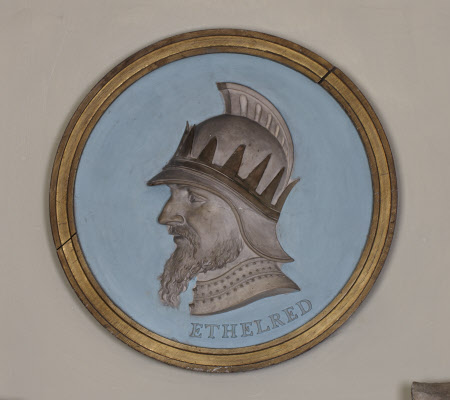Æthelred II and Alfred the Great
Coade
Category
Art / Sculpture
Date
circa 1775 - 1787
Materials
Painted artificial stone
Measurements
515 mm (Diameter)
Place of origin
Lambeth
Order this imageCollection
Kedleston Hall, Derbyshire
NT 109000
Summary
Artificial stone, painted, in gilt wood frame, Æthelred II (c.966-1016), and Alfred the Great (847-49-899), Coade's Artifical Stone Manufactory, Lambeth, c.1775-1787, inscribed 'ETHELRED' and 'ALFRED' respectively at base of busts. A pair of medallions with relief portraits of Æthelred II, King of the English, and Alfred the Great, King of Wessex and the Anglo Saxons. The background of the medallions are painted pale blue and the crowns of both kings are painted gold which has dulled.The medallions are framed in gilt wood.
Full description
The medallions were produced by Coade's Manufactory of Lambeth, London. They are derived from moulds produced by 'Bridges of Knightsbridge', an artificial stone manufacturer whose stock-in-trade was auctioned by Christies on 26 May 1775. Lots 8 and 9 of that sale were a pair of medallions of Alfred and Ethelred. Eleanor Coade (1733-1821), the businesswoman who founded the hugely successful Coade's Artificial Stone Manufactory, purchased Bridges' workshop in 1778. She reused Bridges' moulds at her factory, including moulds of the medallions of Alfred and Æthelred (see 'A descriptive catalogue of Coade's artificial stone manufactory[...]', 1784, p. 15, Medallions, no. 298, [Head of] Alfred and no. 299 [Head of] Ethelred'). For other Coade Stone at Kedleston see the signed copies of the Borghese and Medici Vases after the antique (NT 109017.1 and 109017.2) and a pair of recumbent deer (NT 109016.1 and 109016.2). The medallions were installed in Caesar's Hall sometime after 1769 as they are not listed in the 'Catalogue of the pictures, statues, &c. at Kedleston' published that year. They do, however, appear in a hand-written annotation in the so-called 'House Keeper's Book' of 1787 (held at Kedleston Hall) which was used by the then housekeeper Mrs. Garnett as she carried out guided tours of Kedleston Hall. Portraits of both kings were probably loosely based on engravings: Æthelred II after an engraved portrait said to derive from a 'scarce coin' (see British Museum, London, 1943,0410.573), Alfred from an engraving by George Vertue made for Rapin's 'History of England' (British Museum, London, 1935,0522.3.74) which was reused by Benoist for Smollett's History of England, 1757 (British Museum, London, 1874,1010.80). Alice Rylance-Watson February 2019
Provenance
Purchased by Nathaniel Curzon, 1st Baron Scarsdale (1726-1804); identifiable in the manuscript annotation 'Over the Chimneys | Alfred and Ethelred' under 'Caesar's Hall' in the so-called ''House Keeper's Book' of 1787 (a copy of the 1769 Catalogue annotated with the Housekeeper Mrs. Garnett's hand-written notes); Identifiable as 'Alfred and Ethelred' in entry for the 'Tetrastyle Hall' in the 1861 'Catalogue of the pictures, statues, &c. at Kedleston'; purchased with part of the contents of Kedleston Hall with the aid of the National Heritage Memorial Fund in 1986 when the house and park were given to the National Trust by Francis Curzon, 3rd Viscount Scarsdale (1924-2000).
Credit line
Kedleston Hall, The Scarsdale Collection (acquired with the help of the National Heritage Memorial Fund and transferred to The National Trust in 1987)
Makers and roles
Coade, manufacturer after Bridges of Knightsbridge , manufacturer
References
Gunnis 1968: Rupert Gunnis, Dictionary of British Sculptors 1660-1851, London 1968, p. 61 Keynes 1999: Simon Keynes, 'The cult of King Alfred the Great', Anglo-Saxon England, Vol. 28 (1999), pp. 225-356, p. 285

